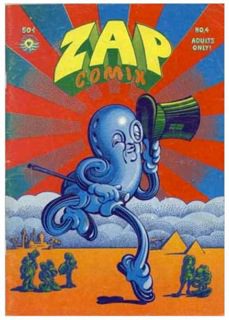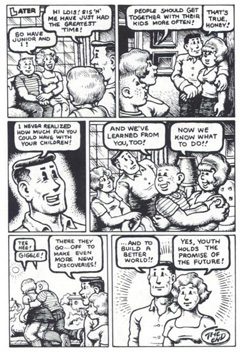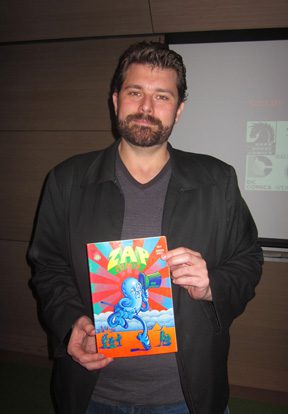The New York Comics & Picture-Story Symposium is a weekly forum for discussing the tradition and future of text/image work. Open to the public, it meets Monday nights 7-9pm EST in New York City. Presentations vary weekly and include everything from historical topics and technical demonstrations to creators presenting their work. Check out upcoming meetings here.
This week’s presentation was given by Charles Brownstein, the Executive Director of the Comic Book Legal Defense Fund (CBLDF) since 2002. A self-described “true believer” of comics, Brownstein worked as a reporter in the ‘90s, and came by his current line of work through Denis Kitchen. Before launching into the tale of unwitting book peddlers convicted of selling obscene materials, Brownstein hearkened back to the late 1950’s, when an obscenity trial ruled against content in William Gaines’ EC Comics’ Tales of Horror.
Senator Estes Kefauver: Here is your May 22 issue. [Kefauver is mistakenly referring to Crime Suspenstories #22, cover date May] This seems to be a man with a bloody axe holding a woman’s head up which has been severed from her body. Do you think that is in good taste?
Gaines: Yes sir, I do, for the cover of a horror comic. A cover in bad taste, for example, might be defined as holding the head a little higher so that the neck could be seen dripping blood from it, and moving the body over a little further so that the neck of the body could be seen to be bloody.
Kefauver: You have blood coming out of her mouth.
Gaines: A little.
Kefauver: Here is blood on the axe. I think most adults are shocked by that.
Fast forward to the 1973 case of People v. Kirkpatrick, when Manhattan bookstore clerks were arrested and convicted of promoting obscene material based on the comics content of Zap #4. Brownstein recounted the ruling of Judge Joel J. Tyler, which deemed work by pioneers including R. Crumb, S. Clay Wilson, Spain, Robert Williams, and other contributors to Zap #4 legally obscene in the first ever obscenity conviction for comic book material. Aside from the tragedy of the censorship of the comics themselves, third-party booksellers, allegedly ignorant of the contents of the comics, were convicted of knowingly distributing offensive material. Even more tragically, Brownstein pointed out that one of the accused, Charles Kirkpatrick, was a 23-year-old Vietnam War veteran. He cited The Village Voice: “an undercover policeman from the Morals Squad walked into the New Yorker Bookshop on West 89th Street and asked for a copy of R. Crumb’s Zap comics, number four. Charles Kirkpatrick, the 23-year-old bookshop manager, sold it to him and was promptly arrested for ‘promoting obscenity.’”
When asked about the CBLDF’s current role as defender of comics, Brownstein replied, “The Fund matters because comics matter, the people who make them matter, and the people who read them matter. There’s still a double standard that comics aren’t entitled to the same rights as other media, and that’s simply not the case. And as long as we’re here it never will be.” He described the lawyers they employ to defend comics cases as “We Will Kill You, LLC.” Though the outcome of the 1973 obscenity case negatively impacted comics for decades after, the present-day defense of comics is in much better hands thanks to the CBLDF’s efforts.
***
Jess Ruliffson is a comics journalist and illustrator who hails from Biloxi, Mississippi and lives in Brooklyn. She is currently working on a graphic novel based on interviews with veterans of the Iraq and Afghanistan Wars. You can read her comics on her blog.







